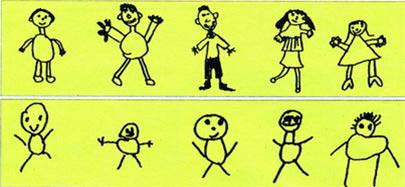According to a study conducted in Germany, excessive television watching limits the intellectual development of children.
At first glance, the drawings may appear messy. But for Peter Winterstein, a pediatrician, they are “small windows showcasing children’s intelligence.” For the past 17 years, he has conducted various tests on students aged 5-6 in Baden-Württemberg, Germany. Occasionally, he asks the children to draw a person.
Some drawings feature bodies with arms, fingers, ears, and legs, while others are oddly shaped. Arms are drawn from the hips, and legs from the head. For Winterstein, the primary cause of this developmental delay is television. He tested his theory with over 1,900 children in the Göppingen district of southwestern Germany.
 |
|
“Small windows into children’s intelligence.” The drawings above were created by preschoolers who watch less than one hour of TV daily, while the images below were made by those who watch over three hours each day. |
The results of this study are surprising. The drawings of children who watch less than one hour of TV daily are complete with all body parts, while those of children who watch more than three hours a day often lack essential features.
To evaluate the drawings, Winterstein and his colleague Robert J. Jungwirth developed a scoring system with a maximum score of 13. They first assessed whether the drawings included all body parts. For each detail such as hair, eyes, nose, torso, or legs, they awarded 1 point. They also considered whether the head, body, and limbs were proportionate.
Winterstein views this methodology as crucial for understanding how preschoolers perceive their drawings. The results are significant: children who watch less than one hour of TV daily averaged a score of 10.4 out of 13, while those who watch more than three hours scored only 6.4 out of 13, which is the lowest score, accounting for only 10% of the drawings.
With this study, Winterstein aligns with other medical professionals like Manfred Spitzer, a neuroscientist and director of the medical center at the University of Ulm, who consistently warn families about the consequences of excessive TV watching among children. Spitzer explains that a mind only collects information if children explore it through the coordination of multiple senses, namely auditory, visual, olfactory, and tactile.
From this perspective, he argues that television is a rather poor source of information compared to the real world. These arguments are further supported by recent studies in the United States: comparative tests conducted with thousands of children over 30 years show that those who watched more TV as children had poorer educational outcomes by the age of 26.
Statistics from 2005 in Germany indicate that children aged 3-5 watch an average of 71 minutes of TV daily, while 13-year-olds watch an average of 108 minutes. These figures may seem normal, but researchers have established a direct link between TV watching and declining academic performance. Moreover, according to a study conducted in North Rhine-Westphalia with nearly 5,500 children, those who watch less TV feel more integrated within their families.
Peter Winterstein states that it can be demonstrated that the impact of television on children’s development is even more detrimental than maternal nicotine exposure during pregnancy.
N.T.ĐA


















































